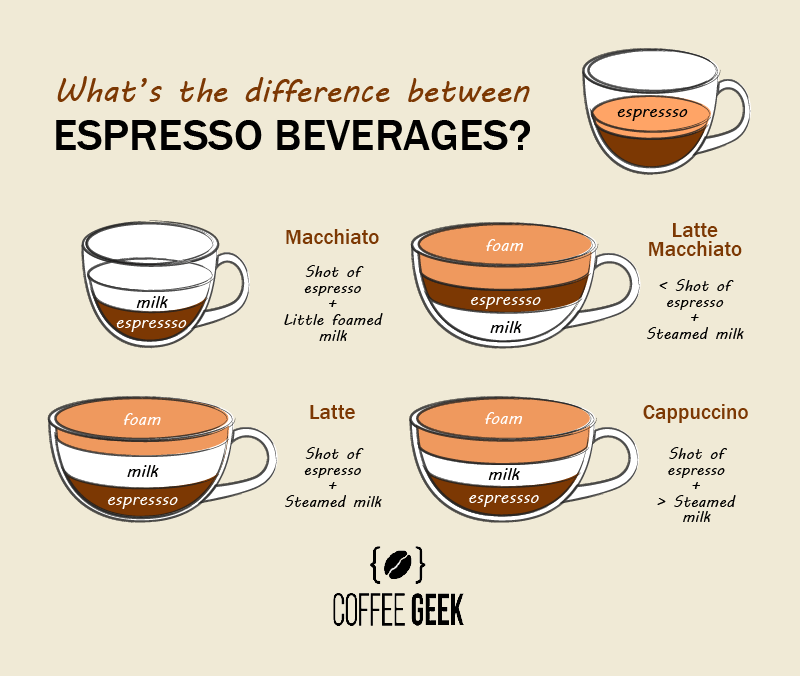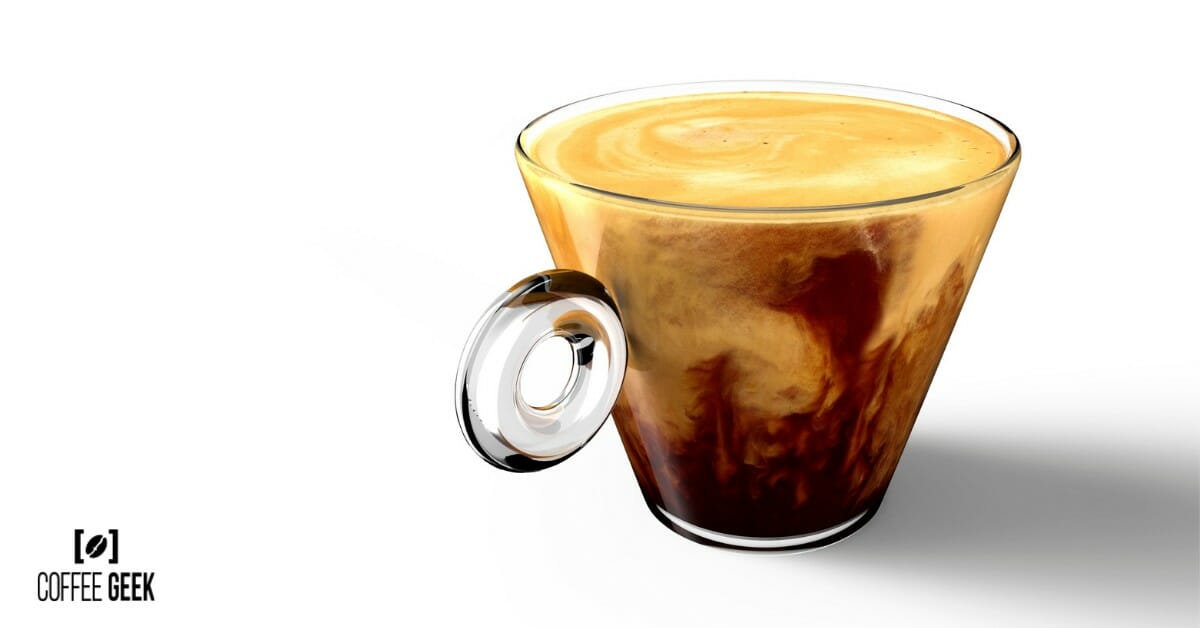Macchiato (mah-kee-yah-tow) or Espresso Macchiato originated in Italy but is widely drunk around the globe.
If you find yourself in Italy ordering one, pronounce “ch” not in the English way, but as “k”.
So, you’ve ordered your first Macchiato – What should you expect to find in your cup?
A traditional Macchiato comes to life when a barista adds a small amount of milk into a single shot of espresso.
Therefore, it is more delicate than Espresso coffee. There is some sweetness, too, a foam is created, and many places delight customers with an Instagrammable pattern on top.
Just like you, I love to take pictures of a nicely served java.
There are as many kinds of coffee drinks as there are brewing techniques, talented baristas, and places serving these creative drinks, from coffee chains, craft coffee shops with expensive steamers to classic and classy cafetières, or hidden gems in small alleys.
How to identify a Macchiato coffee, and, more importantly, how to identify a good one?
- What is in a Macchiato?
- Is Espresso Macchiato any different from an Espresso?
- How to tell Espresso and Macchiato apart from Latte Macchiato, Cafè Latte, or Cappuccino?
- How to make a Macchiato coffee?
- How to drink a Macchiato coffee?
- Where did I enjoy a good Macchiato coffee?
- Latest trends in Macchiato and Espresso-based drinks
What is in a Macchiato?
It indeed is a tiny coffee bomb. With the highest ratio of espresso to milk, without overwhelming you, it literally leaves a mark.
The small amount of milk, heated to 60–66 °C (140–150 °F) turns an espresso into something else, something macchiato – meaning marked in Italian.
Portuguese even call it “Café Pingado”, which means coffee with a drop.
You can find it in Spain under the name “Cortado”, however, their version is a double shot, more flat, with a milkier texture. In the US, it is often mistakenly associated with the Caramel Macchiato or flavored Mocha.
This article will introduce real Espresso Macchiato to you.

Is Espresso Macchiato any different from an Espresso?
Oh, yes. The main differences between espresso and Macchiato are:
- Espresso is a drink by itself.
- Macchiato contains espresso, plus steamed milk (max. 2 teaspoons)
- Macchiato is bigger in volume (equal to Double Espresso aka Doppio)
- Macchiato can have more “shades of brown”
- Macchiato is more delicate in taste and strength.
How to tell Espresso and Macchiato apart from Latte Macchiato, Cafè Latte, or Cappuccino?
So many types of espresso-based coffee drinks, so little time. Let’s simplify it.
Espresso = No milk at all.
Macchiato = Barista adds a small amount of foamed milk to a single shot of espresso.
Latte Macchiato = Vice versa. Less than a shot of espresso is added to steamed milk. It is served in a tall glass with a “layered look” and microfoam and crema latte art on top. Sometimes there are options with syrups available.
Caffè latte = Barista adds milk to an Espresso, but it has more foam than a Macchiato. It can be mixed and not layered.
Latte literally means milk (Café au lait). The original one is drunk hot, but there are iced versions out there, too.
Cappuccino = Not as strong as Macchiato coffee, and milkier. After all, it is named after Italian Capuchin monks – because of the foam top and its color.

How to decide between Macchiato vs Espresso coffee? I would say that, if you like your coffee black, small, and strong, go for the espresso.
If you are in a mood for some milk sweetness in your drink, go for a Macchiato coffee.
If you want the milk to stand out more than the espresso inside your coffee drink, order latte Macchiato or Caffeè Latte.
Personally, I can appreciate them all, and if I had to choose – Espresso in the mornings, Macchiato in the afternoons.
Just as Dale Cooper — the fictional detective from the TV show Twin Peaks, enjoy your “damn fine” coffee drink with a smile.
I hope that this article will help you to spot a Macchiato right away :) But first:
How to make a Macchiato coffee?
Espresso Macchiato (its full name) can be served in a glass or a ceramic coffee cup. If you prefer a lot of coffee, ask for double.
Mind you, it will be stronger, too. In case you prefer a bigger cup and smaller espresso kick, drink a Cappuccino.
How does it come to life? A barista (or you, if you are up for it and have a proper espresso machine and ingredients), prepares a shot of espresso by heating the water to about 200 degrees Fahrenheit.
The key is in the “press” part of the word – the machine needs to be set to 10 – 15 pressure bars, and push the steam through the grounds for 25-30 seconds.
That is when the magic happens.
Preparing the famed foamed milk is crucial, too. It is steamed until the espresso milk foaming pitcher feels warm (no more than 150 °F) – do not burn yourself, or destroy the taste.
Then “stain” your espresso with a small amount of milk. Remember, always add milk into espresso, not the opposite way.
And do not add too much, or you will end up with a Latte/Cappuccino. One to the max. two tablespoons are just right.
Talking about ingredients, beans you can use to make Espresso Macchiato include any Arabica fine grind, slow roast, from medium to dark roast.
It allows aromas in this drink to unfold and its body and texture are perfect for coffee creations with milk. Go Italian, if you want to have the original one.
Organic or locally roasted beans are always a good choice, but more on that later.
Regarding milk, cow milk is the classic choice in coffee drinks. Fatty, quality milk with a protein content above 3 percent gives Macchiato more body and milk foam. Full-fat whole milk is a good choice.
Of course, you can opt for a lactose-free version, or plant-based vegan-friendly soy, coconut, almond one… I live in South East Asia and sometimes enjoy my coffee with rice milk.
Not Espresso Macchiato, though, as rice and coconut milk lack fat and protein, and are not good for foaming.
How to drink a Macchiato coffee?
Serve it in an espresso cup or a small transparent glass, and sip, appreciating the Macchiato’s flavor, enjoying both body and the milk foam of it. As Italians say, enjoy “the pausa”.
A cup to-go is not recommended. Especially the non-reusable one. However, serving depends on a country and the place (especially if you visit a multinational coffee chain). You can also get it in glass, or demitasse.
If you have a sweet tooth, combine it with biscotti or brioche.
They are sometimes served along with it, even if it is more common for milkier espresso-based drinks, such as Latte.
Caramel and vanilla-flavored biscotti are my favorites when it comes to Macchiato.
PS: If you need to cleanse your palate beforehand, drink the water that comes with stronger espresso-based drinks.
However, if you would visit Vietnamese traditional cafes, they are meeting and chilling places, where people spend a lot of time, and water can be used as a palate cleanser afterward, too, before getting the complimentary traditional trà đá, cold, but not sweet tea, or ordering something else.

Where did I enjoy a good Macchiato coffee?
I have had some good Macchiatos in coffee shops in San Francisco, New York, Hong Kong, Chiang Mai, which is where I live, or favorite spots like Japan.
That one literally “slayed” as they had Slayer espresso coffee machines and talented staff. Basically, my advice is to never stop exploring the coffee world.
I also try to make one at home from time to time, using freshly roasted beans, a Moka pot, and a milk frother, electric, or manual.
Plus, mastering the electric milk frother feels like being a wizard, mastering a magic wand.
However, I love specialty coffee, the cafe atmosphere, watching baristas, meeting their owners, and other patrons, so I prefer to go outside if I can.
Also, nothing beats a perfect froth made with an espresso machine.
Latest trends in Macchiato and Espresso-based drinks
Cold brews are on the rise, and so is Cold Brew/Iced Espresso Macchiato! Many places serve it with caramel, cinnamon, or syrup, for example, a vanilla one. It is a good coffee drink choice on hot summer days.
Another trend in the last 2 years is trying plant-based milk in your drink, whether for curiosity, or dietary purposes. The most popular are definitely:
- Soy milk, popular among vegans.
- Oat milk, suitable for vegans, lactose-intolerant people, or people with a nut allergy. This one is great for foaming.
- Almond milk, which is creamy and nutty. Great for foaming, as well.
- Coconut milk, which has a creamy texture.
- Rice milk, good for people with cardiovascular issues, such as hypertension (it is cholesterol-free) but not good for creating milk foam.
Organic milk or organic products, such as eco-friendly or fair trade coffees, are also something I support and would like to mention.
They are a way of supporting local communities, and supporting coffee-growing sustainability, biodiversity, and in return (except a good feeling and wonderful taste), provide fewer health risks (as they do not use many agrochemicals)
I have mentioned that Macchiato is best enjoyed from a ceramic cup.
However, talking about doing something for the planet – if you are really busy, bring your own reusable cup, and if you buy coffee, look for sustainable packaging design.
I believe we can be a tad hedonist and act responsible at the same time, especially now, in the 2020s.
Did you like this article explaining what Macchiato is? Do you agree with me? And where did you drink a good Macchiato coffee?
Let me know in the comments!

